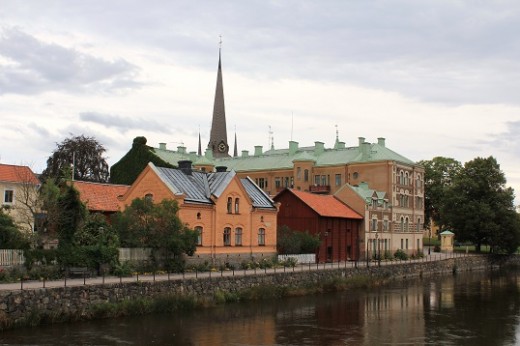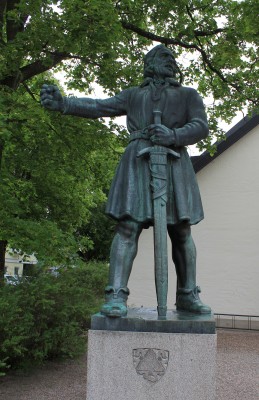
Caressed by sun-drenched archipelagos, storybook woodlands, and verdurous islands lush with greenery, Eastern Sweden is the heart of Summertime Scandinavia. Blue skies and fair weather grace the festive season now that most of the ice and snow has melted away, revealing mushrooms and lavender stalks. Wooden lodges painted in warm colours hang close to the harbours of Lake Hjälmaren, while old steamboats cruise by leisurely, casting aside lily-pads. The smell of cooking fires and freshly squeezed berries outweigh of the musk of the forest and the river, while lighthearted talk and jovial drinking dampens the eternal prattling between fox and rabbit. There are no finer accommodations for a Bohemian lifestyle.
Västmanlands län is a county located 130 km west of Stockholm. Within it lies Arboga kommun, a municipality which seats the city of Arboga itself. Founded during Medieval times, Arboga was an important centre for the mining of iron ore, fostering the strength and integrity of the Kalmar Union.
The Kalmar Union was a unified government of all Nordic countries. The alliance was a political check against the Holy Roman Empire’s northward expansion into Europe. Denmark, particularly threatened by Germanic kingdoms, pressed Sweden into funding its wars against the Germans with iron.
The clamor of Swedish peasants could not go unheard. Furious because of increased taxation and export of iron, they protested against Eric of Pomerania, King of the Kalmar Union. When Sweden ceased its iron exports, the king refused to negotiate and continued to collect taxes and tributes. Miners and the underclass responded by torching several castles throughout Sweden, weakening the monarchy’s influence and power over its subjects for the time being.
In 1435, Arboga was the site of Sweden’s very first Riksdag (national assembly). It convened to appoint Engelbrekt Engelbrektsson as commander-in-chief of the Swedish army, who was leader of the rebellion against Eric of Pomerania and became a national hero for Swedes. The following year, Engelbrektsson was assassinated by Måns Bengtsson, a nobleman, at Lake Hjälmaren in retaliation for the burning of aristocratic lands. Eventually, Sweden fought a series of wars against Denmark and Norway to earn its independence from the Kalmar Union.

Arboga was briefly home to Sweden’s liberator King Gustav I and his daughter Princess Cecilia who became the Countess of Arboga. Gustav Vasa charted the weapons factory Jädersbruk in the mid 1500s. It produced high quality sidearms such as long swords and daggers for military use by officers. By the 1800s and after the fall of the Swedish empire, the factory produced various kinds of wire instead of weapons.
Cecilia Vasa’s home in the 16th century was Helge And, a church, where she attended to Arboga’s domestic trade and exports. It was also her base of operations in managing a pirate fleet in the Baltic Sea that plundered English and Dutch vessels on their way to Russia. In modern times, this very building serves as Arboga’s town hall, though probably with less political intrigue.
Arboga also features two other churches which dominates the cityscape skyline: Heliga Trefaldighets kyrka (the Holy Trinity Church) and Sankt Nicolai kyrka (St. Nicholas Church). The Holy Trinity Church was established in the late 13th century by a group of Franciscan monks known as Gråbröderna (the Grey Brotherhood). Erikskrönikan, A medieval historical prose, likens the Grey Brotherhood as healers, protectors, and teachers of the sick and poor. The order stayed in Arboga for 300 years until they were forced out when Sweden was unified by Gustav Vasa and broke its allegiances to the Roman Catholic Church, choosing to follow Lutheranism.
St. Nicholas Church is located in the northern part of Arboga. It traces its history back nearly 1000 years and has been rebuilt many times over. Its most recent addition was constructed in the mid 1990s when its tower was renovated after collapsing in 1889.
Arboga retains its medieval charm and relics of its imperial might even in the modern era. In the Summer, Arboga hosts many carnivals and festivals including the Arboga Carnival in June, Medieval Days in August, Jädersbruk Festival in September, and others. Tourist attractions in Arboga include: Västerlånggatan, the oldest road in the city; Carl Eldh’s statue of Engelbrekt Engelbrektsson which overlooks the Iron Market square; Ladbron quay, with its bright red warehouses and scales where Arboga’s iron had been weighed, loaded, and transported for centuries until Hjälmare Canal—the oldest man-made waterway in Sweden—was constructed.
Newer events are also taking place in Arboga. Peace Monuments of War Material was hosted in Arboga in 2012. Sculptors from all around the world used scrap metal and other discarded items of military use to create art. Zhu Ying from China took first place with her piece, “Flower in Arboga” which utilized aeroplane propellers and pieces of a fuselage from a fighter plane mixed with concrete and steel to craft a flower… a symbol of peace, friendship, and love created from weapons of war.
Arboga has a fascinating cultural heritage that has thrived for over 1000 years and continues to delight tourists and historians alike. Yuba-Sutter county has even felt the influence of Arboga. Swedish-Americans in the early 20th century immigrated to the Sacramento valley, choosing to settle near Olivehurst, California. These settlers were from the Mission Covenant Church of Sweden and its pastor named their new home after their old one.
Arboga, California is perhaps better known for its internment camp for Japanese-Americans during the 1940s. The remnants of the Arboga Assembly Center, located a few miles west of Oroville Highway, once confined 2,500 people of Japanese descent due to President Franklin Roosevelt’s Executive Order 9066. Distrust and suspicion of Asian people coupled with the chaotic hysterias of war after the attack on Pearl Harbor “justified” the internment of Japanese Americans across California. Currently, the Marysville Japanese-American Citizens League (JACL) is campaigning for a permanent memorial to be placed at the remains of the Arboga Assembly Center, which is a California Historical Landmark.
I come from a long line of yokels, mostly fishermen and truckers. Some then, find it odd that I am an aspiring economist and sociologist. The way I see it: my family’s tales of the road and the river humbled me, yet caused a thirst for adventure . I also like to write feature stories about interesting places and the beautiful people that live there. Like Yuba-Sutter.





Comment Policy: Comments are welcomed and encouraged. However, the editorial board reserves the right to edit or delete, without notice, any comments submitted to the blog. For more details, see our full Comment Policy.